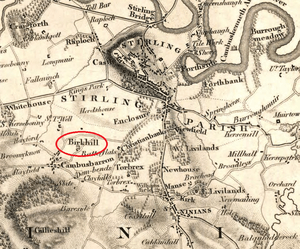Birkhill House, Stirling facts for kids
Birkhill House is a historic house located in central Scotland. It stands between the city of Stirling and the village of Cambusbarron. This old house has a long and interesting past.
History of Birkhill House
People have lived on the land where Birkhill House now stands for a very long time. Evidence shows that a community existed here around 1700 BC. This was when the village of Cambusbarron first became a permanent settlement.
In the 1800s, some people thought Birkhill House might be built on the site of an old Roman villa. This idea came from finding small pieces of Roman glass nearby. However, experts today do not think this theory is correct.
The house we see today is shown on an old map from 1817. This map was made by John Grassom and shows the 'County of Stirling'. Back then, the Birkhill estate included the main house, stables for horses, and an orchard with fruit trees.
Amazing Discoveries
Many interesting archaeological finds have been made around Birkhill House. Archaeology is the study of human history through digging up old objects and sites. The first discoveries were made in February 1879.
These finds included ancient stone burial boxes called cists. They also found old bones and special pots called food vessels. These vessels were likely used to hold food or drink for people buried in the cists.
It can be tricky to know the exact spot where everything was found. This is because the names 'Birkhill' and 'Cambusbarron' were not always used clearly in old records. But we know the main discovery areas were on both sides of Birkhill House. Another important spot was an old sandpit to the west of the house.
Over time, the land around Birkhill House has changed a lot. This makes it hard to pinpoint the exact original locations of all the finds. However, these discoveries show that the area has been very important for a long time.
Today, you can see many of these ancient objects. They are kept safe in two museums. Some are at the Stirling Smith Art Gallery and Museum in Stirling. Others are at The National Museum of Antiquities of Scotland in Edinburgh.


